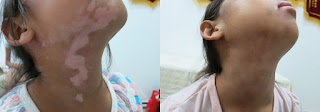Vitiligo is a common acquired pattern or generalized skin pigmentation
disease. Due to the disappearance of skin melanocyte function, but the mechanism
is unclear. All parts of the body can occur, common in the back, wrist, forearm,
face, neck and genitalia around. Female genitals can also occur, mostly young
women.
First,Autoimmune
1, vitiligo patients with other autoimmune diseases and other autoimmune diseases in patients with vitiligo than the average person was significantly higher.
2, the patient can be detected in a variety of serum autoantibodies, and anti-melanocyte antibodies, the positive rate of 50-93%, and with the severity of the disease.
3, malignant melanoma patients with vitiligo was significantly higher than normal, a group of 450 patients with melanoma abroad, 29 cases (6.4%) with vitiligo.
4, vitiligo patients with cellular immunity and humoral immune abnormalities, such as changes in T cell subsets, soluble interleukin-2 receptor and some changes in cytokines.
5, vitiligo disease persistent chronic, in line with the general laws of autoimmune disease.
6, vitiligo not only affect the skin melanocytes, but also affect the eye, ear and other pigment cells.
7, some patients with the same shape positive.
8, the pathological changes in the white spot on the edge of the mononuclear cell aggregation, in line with late-type hypersensitivity, white margin of the epidermis Langerhard cells increased.
9, corticosteroids and immunosuppressive agents effective.
Second, Melanocytes Own Damage
In the process of synthesis of melanin, the intermediate products such as dopa dopaquinone dopa pigment 5-6 dihydroxy indole and so on, are belong to the monophenol or polyphenolic compounds, the accumulation of phenols or produced Many of the melanocytes have selective cytotoxicity, can damage melanocytes.
Third, The Neurochemical Factors
Nerve endings release of chemical media such as norepinephrine, acetylcholine or other substances may have a damaging effect on melanocytes.
Fourth, Genetic Factors
Genetic factors and the incidence of the disease plays a certain relationship, according to reports at home and abroad 3-40% of patients with positive family history.
Five ,Other Causes
1, some drugs: such as anti-cholinesterase drugs, light-sensitive drugs, sulfur-based drugs, thyroxine, norepinephrine, vitamin A acid drugs, vitamin C,
2, mental factors, sun, trauma, surgery, friction, etc .;
3, wine and seafood;
4, after a variety of infectious diseases.
Six, Comprehensive Reasons
Vitiligo is a result of melanoma cells due to significant reduction or loss caused by skin, mucous membranes and hair pigmentation disease. Vitiligo pathogenesis is more complex, including autoimmune theory, melanoma cell destruction theory, neurochemical factors, genetic factors, trace elements and mental factors, microcirculation, diet, mood, alcohol and tobacco, drug stimulation, mechanical stimulation , Surgery, trauma, and so on a variety of incentives can cause the incidence of vitiligo, it is recommended to check clearly, and then symptomatic treatment, in order to achieve the desired therapeutic effect.
First,Autoimmune
1, vitiligo patients with other autoimmune diseases and other autoimmune diseases in patients with vitiligo than the average person was significantly higher.
2, the patient can be detected in a variety of serum autoantibodies, and anti-melanocyte antibodies, the positive rate of 50-93%, and with the severity of the disease.
3, malignant melanoma patients with vitiligo was significantly higher than normal, a group of 450 patients with melanoma abroad, 29 cases (6.4%) with vitiligo.
4, vitiligo patients with cellular immunity and humoral immune abnormalities, such as changes in T cell subsets, soluble interleukin-2 receptor and some changes in cytokines.
5, vitiligo disease persistent chronic, in line with the general laws of autoimmune disease.
6, vitiligo not only affect the skin melanocytes, but also affect the eye, ear and other pigment cells.
7, some patients with the same shape positive.
8, the pathological changes in the white spot on the edge of the mononuclear cell aggregation, in line with late-type hypersensitivity, white margin of the epidermis Langerhard cells increased.
9, corticosteroids and immunosuppressive agents effective.
Second, Melanocytes Own Damage
In the process of synthesis of melanin, the intermediate products such as dopa dopaquinone dopa pigment 5-6 dihydroxy indole and so on, are belong to the monophenol or polyphenolic compounds, the accumulation of phenols or produced Many of the melanocytes have selective cytotoxicity, can damage melanocytes.
Third, The Neurochemical Factors
Nerve endings release of chemical media such as norepinephrine, acetylcholine or other substances may have a damaging effect on melanocytes.
Fourth, Genetic Factors
Genetic factors and the incidence of the disease plays a certain relationship, according to reports at home and abroad 3-40% of patients with positive family history.
Five ,Other Causes
1, some drugs: such as anti-cholinesterase drugs, light-sensitive drugs, sulfur-based drugs, thyroxine, norepinephrine, vitamin A acid drugs, vitamin C,
2, mental factors, sun, trauma, surgery, friction, etc .;
3, wine and seafood;
4, after a variety of infectious diseases.
Six, Comprehensive Reasons
Vitiligo is a result of melanoma cells due to significant reduction or loss caused by skin, mucous membranes and hair pigmentation disease. Vitiligo pathogenesis is more complex, including autoimmune theory, melanoma cell destruction theory, neurochemical factors, genetic factors, trace elements and mental factors, microcirculation, diet, mood, alcohol and tobacco, drug stimulation, mechanical stimulation , Surgery, trauma, and so on a variety of incentives can cause the incidence of vitiligo, it is recommended to check clearly, and then symptomatic treatment, in order to achieve the desired therapeutic effect.





